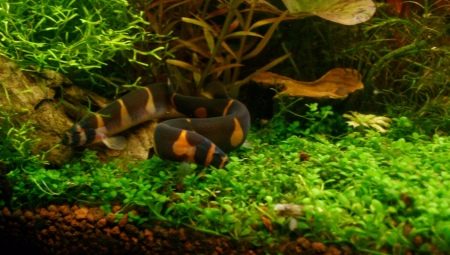Akantophthalmus is a very interesting aquarium fish and attracts the attention of others. His body has a serpentine shape, and transverse stripes give the appearance an extraordinary and originality. However, the fish is not among the favorites and is rarely found in amateur aquariums. In this regard, many aquarium enthusiasts know very little about it and are in no hurry to acquire it as a member of their underwater community.
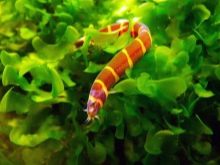
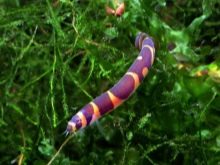
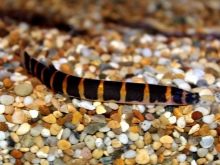
Description
Akantophthalmus, also known as worm fish or barbed-eye loach, belongs to the order of Carp-like, family of loachweed, and has been known in scientific circles since the end of the XIX century. The first description of the fish was made in 1846, while in the USSR it was introduced only in 1973.
At first, the popularity of outlandish fish was great, aquarists actively engaged in its breeding and shared their observations with each other. However, over time, interest in acantophthalmus began to weaken, and at present, fish can only be seen by true aquarium enthusiasts.
Acantophthalmus translated from Latin means “torn eye”. This name was given to the fish thanks to corollas made of thorns, which are located near the eyes and give them some tear.
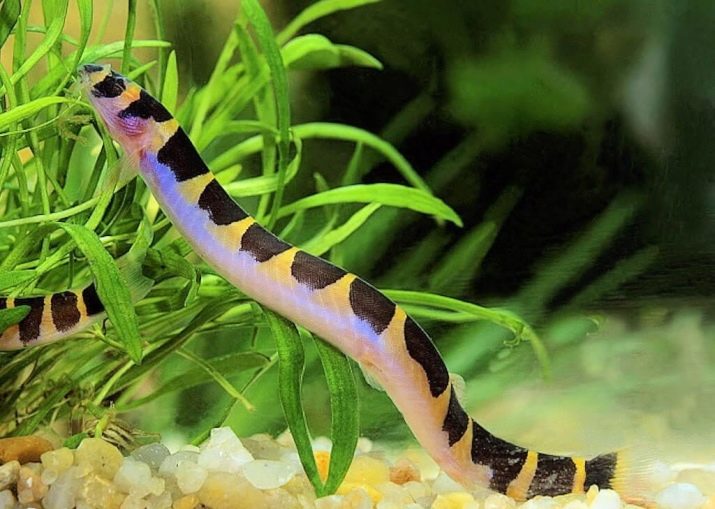
The species belongs to the category of natural and is quite widely found in the wild. The distribution area of acanthophthalmus is considered to be Southeast Asia and India. There fish live in bodies of water with a weak course and an abundance of snags and tree roots.
Representatives of this species have a very outstanding appearance: they have a worm-like, slightly flattened body on the sides without a lateral line and with small scales. The head is small, the eyes are protected by a transparent leathery film, the mouth is quite low and surrounded by several pairs of sensitive whiskers. With their help, acantophthalmus feels obstacles and seeks food. The fins are quite small - they do not take any part in the movement of fish.
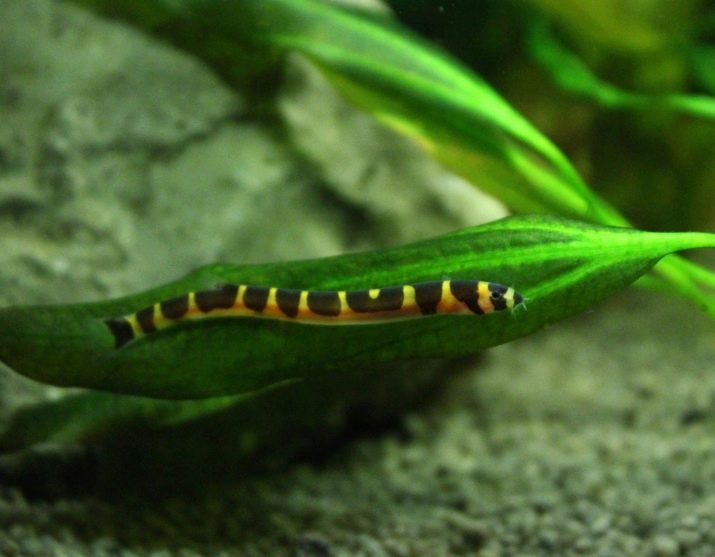
Acantophthalmus moves in water exclusively with the help of a long and moving body. The fish cleverly maneuvers between thickets and tree roots, which is why from afar it resembles a small snake.
The good maneuverability and streamlining of acanthophthalmus is also facilitated by their skin, which has a very smooth texture and is covered with the finest scales. The size of the fish is not very impressive - adult females barely reach 12-13 cm. Males are slightly smaller than females: their body length is only 10 cm. The body of acanthophthalmus is covered with dark brown stripes, the number of which varies depending on the sex, size and type of individual, but averages 12-17 pieces.
The fish prefers bottom life and is very active at night. The species does not belong to the category of schooling flocks, however, in open reservoirs, acanthophthalmus group in small groups of up to ten individuals.
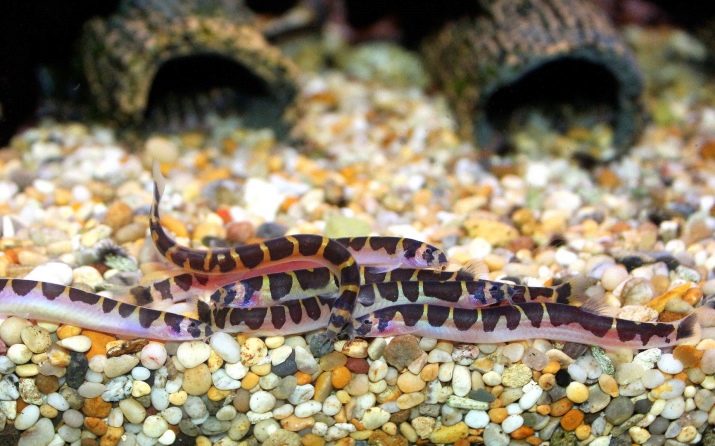
Their life in natural conditions varies from 5 to 10 years, which depends on the variety.
As for the nature of acanthophthalmus, then in an aquarium they behave quite peacefully. Unlike some other types of aquarium fish, these individuals perfectly tolerate loneliness. This property allows you to keep in the aquarium only one individual, while not causing her any damage in terms of mood and health. But more often they are settled by small companies of 5-6 copies. This makes them more active and interesting for outside observation.

Varieties
Today, the most popular among aquarists are three types of acanthophthalmus.
- Acanthophthalmus Myers (Acanthophthalmus Myersi) It is a small fish with an elongated, worm-like and round body. The length of the adult does not exceed 8 cm, and Thailand is considered the birthplace of the species. The fish is distinguished by a small head, a blunt snout and a small, inconspicuous scale. Three pairs of whiskers are located around the mouth, and under each of the eyes there is a pointed spike, which, when frightened or excited, rises perpendicular to the head.
The eyes of fish are small in size, capable of being drawn in by a transparent leathery film when it is instilled into the bottom soil. Acantophthalmus of this species have a bright yellow beautiful color with brown stripes closing on the abdomen into the ring, the number of which reaches 12-13 pieces. Males, unlike females, have sharper pectoral fins and look much slimmer.
Myers acanthophthalmus puberty occurs by 8-12 months, fecundity reaches 800 eggs per spawning, and their hatching is observed in 24 hours. Individuals of this species are distinguished by the lowest life expectancy of all aquarium species of acanthophthalmus - they live no more than 4 years.
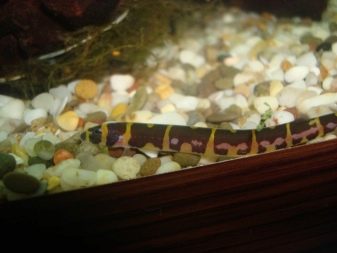
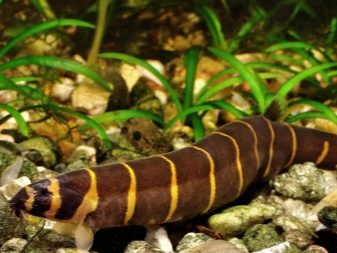
- Acanthophthalmus of Kuhl (Acanthophthalmus Kuhli) are natives of the islands of Sumatra and Java. They got their name in honor of the German zoologist Heinrich Kühl (1797-1821), who discovered and first described the previously unknown species. Fish have a snake-like plastic body, painted in pink and yellow colors. Dark brown, almost black stripes are arranged vertically and decorated with longitudinal strokes of the same color as the main background.
The number of bands in this species varies from 12 to 17 pieces, which depends on the sex of the fish. Males are traditionally smaller than females and barely grow up to 10 cm (females often reach 12-13 cm). Fish lead a near-night lifestyle and, with proper care and good conditions, live up to 10 years.
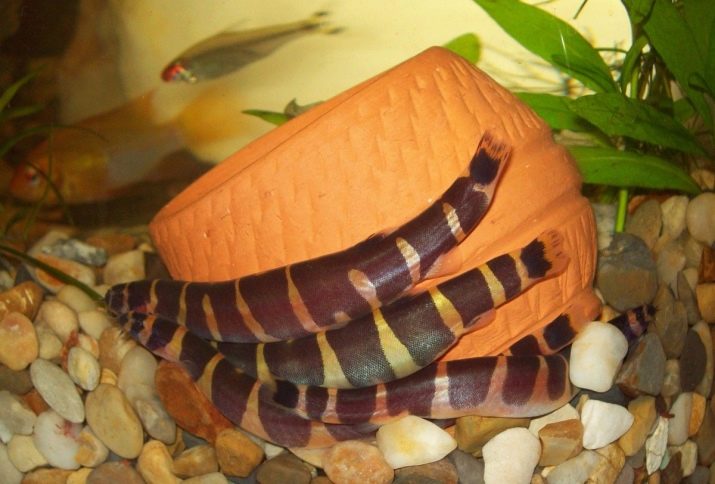
- Acanthophthalmus semi-belted (Acanthophthalmus Semicinctus) is a native of the Malacca Peninsula and the Sunda Islands, which are located in southeast Asia. Fish have a cigar-like body, a thin snout and a mouth directed downward, surrounded by three pairs of whiskers. The case is painted in sand tones and has 12-16 black non-sticky stripes. Only four of them form a ring - three near the head and one at the tail.
The head of fish is small and devoid of scales, eyes are small, having a protective film. The infraorbital spines are distinguished by their bifurcated structure, the fins are small and soft to the touch, while the dorsal is slightly shifted to the tail. Maturity in fish occurs only by the year, life expectancy is not more than 5 years.

Who can I keep in the aquarium?
Acanthophthalmus is a fairly non-conflict fish and is compatible with most calm species. They can be kept together with tetras, zebrafish, Asian loaches, gourami, scalars, apistograms and even shrimp. These species are not prone to territorial behavior and get along well with each other.
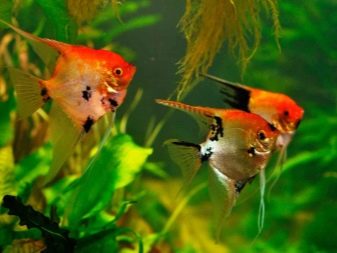
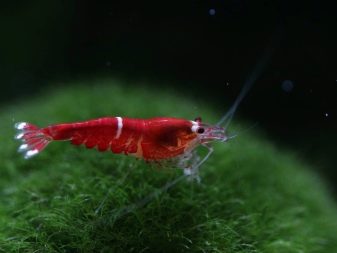
Low compatibility is observed in acanthophthalmus with akara, crucian carp, laboe, goldfish, carp, bobia, most cichlids and with an astronotus.
Some of these species are prone to protecting their territory and will not allow neighbors to swim on it, while others are too large for the neighborhood with miniature representatives of loachweed. Also acanththalmus it is not recommended to lodge with excessively mobile and annoying fish, which will prevent them from resting calmly on the ground in the daytime.
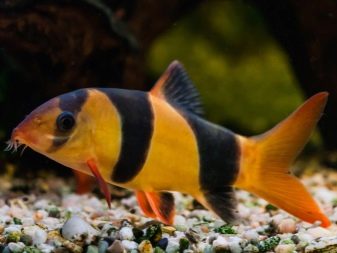

Growing conditions
Acanthophthalmus belongs to natural species and when aquarium content need to create conditions close to natural.
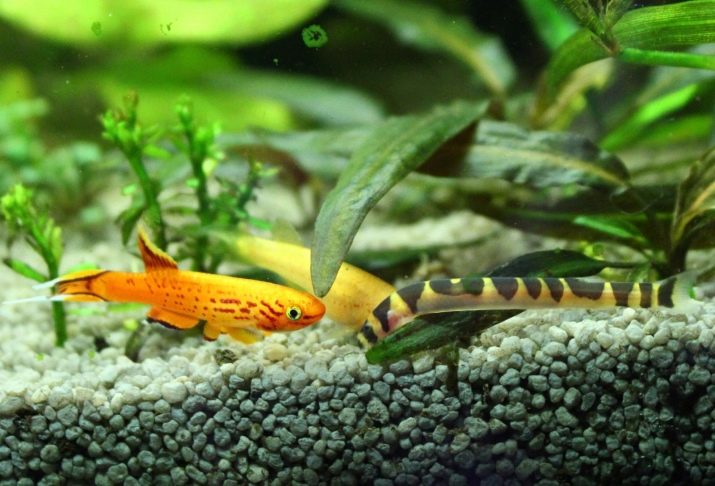
In this regard, special requirements are set for equipping the aquarium, which is very important to observe.
- In view of the benthic lifestyle of fish, the tank should be bought square or rectangular. Round models due to the small useful bottom area for acanthophthalmus are not suitable. The volume of the vessel should be selected taking into account the number of adults: it should not be less than 70 liters for 5-7 fish.
- Coarse sand is used as soil, pre-calcined in the oven for half an hour at a temperature of 150 degrees. Its layer should be at least 5 cm, which is due to the tendency of the fish to bury in the ground. For the same reason, the use of gravel and pebbles is not recommended, as fish will often be injured by sharp stones and will not be able to lead a familiar benthic lifestyle. At the bottom of the tank there are various decorative elements in the form of snags, grottoes and caves.
- It is advisable to plant thick algae, which will shade the aquarium in the daytime. You can green the pond for acanthophthalmus with Javanese moss, Thai fern or tiger lilies.
- A glass cover or mesh must be present on top of the aquarium, since acanthophthalmus can jump out of the water. However, this is not due to the temperament of the fish. The fact is that with a decrease in atmospheric pressure, acanthophthalmuses become too excitable and begin to move randomly along the walls of the tank. As a result of such activity, especially quick fish jump out of the aquarium and die on the floor near the reservoir, if the owner does not notice such a misfortune.
- When installing the compressor, it is necessary to place it as low as possible, so that air bubbles go from the bottom to the upper layer of water. As a filtering system, it is recommended to use a bottom filter or a conventional medium-sized internal filter. Fish prefer a weak current, and therefore it is better not to use powerful models.
- As for water, its temperature should be in the range of 22-28 degrees, the acidity is 6.5-7.2 pH, and the hardness does not exceed 5-6 dH.If one of these indicators does not meet the standards, then acanthophthalmus will immediately signal this to the owner, floating from the bottom to the surface.
- Regarding illumination, we can say the following: Acantophthalmus does not like bright light and in the natural environment prefers to be in bodies of water with natural shading. The same conditions must be created in the aquarium: it must be placed in the shaded part of the room, and if this is not possible, then create an artificial shadow.
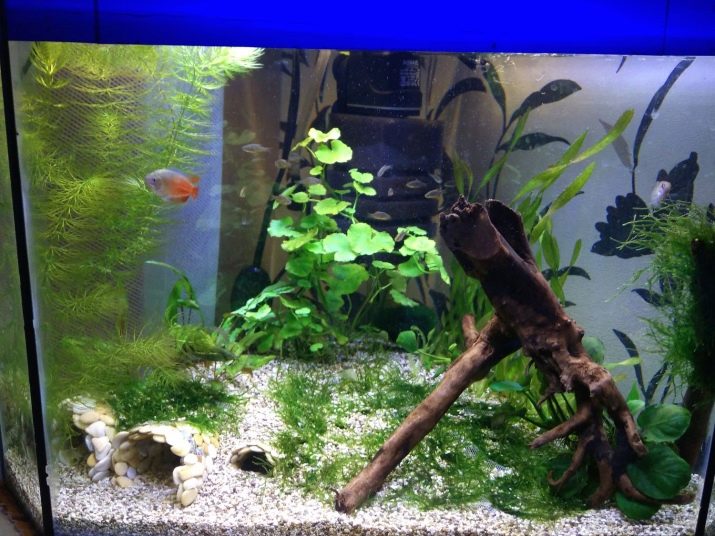
Feeding rules
The diet of acanthophthalmus is not much different from the menu of other aquarium fish and consists of plant and animal food. They really like small snails, tubule, bloodworms, carriage, enchitrea and cyclops, as well as any plant fibers and spirulina. Food is given to them in a dry, lively and frozen form.
Very good results feeding of acanthophthalmus with specialized feeds with a high content of carotenoids of natural origin. Such formulations contain a complete set of necessary substances that are properly balanced and in acceptable combinations.
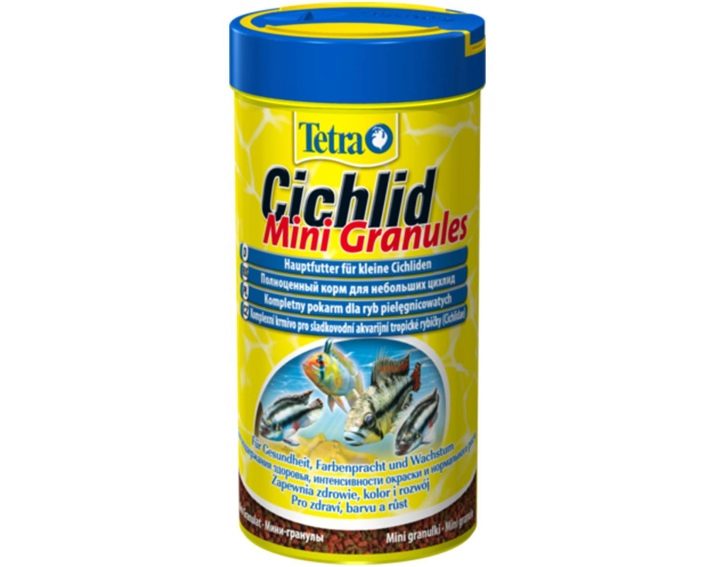
The constant use of such feeds contributes to the excellent health of acanthophthalmus and significantly enhances their color, making the colors bright and expressive.
As for feeding fish with live food, in this case you need to be very responsible and do not be lazy to soak it for half an hour in a solution of the drug "Ichthyphor". This requirement is due to the high risk of infection with infectious diseases, the carriers of which are often living organisms. As an alternative to live food, you can use frozen cubes that have undergone the necessary processing and are completely ready for use.
However, after all stages of disinfection, such food loses some of its beneficial properties.
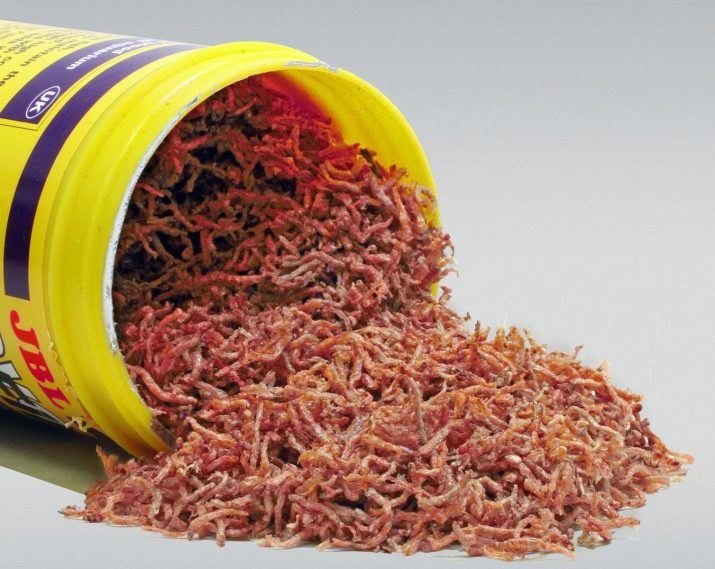
It is recommended to feed acanthophthalmus at night, a couple of hours before dark or by switching off artificial lighting. At the same time, food should sink to the bottom, where it will be picked up and eaten right there. Servings must be calculated in such a way so that the food is completely eaten by fish in 5 minutes. Otherwise, its residues will accumulate at the bottom of the aquarium, begin to rot and lead to clouding of the aquarium water.
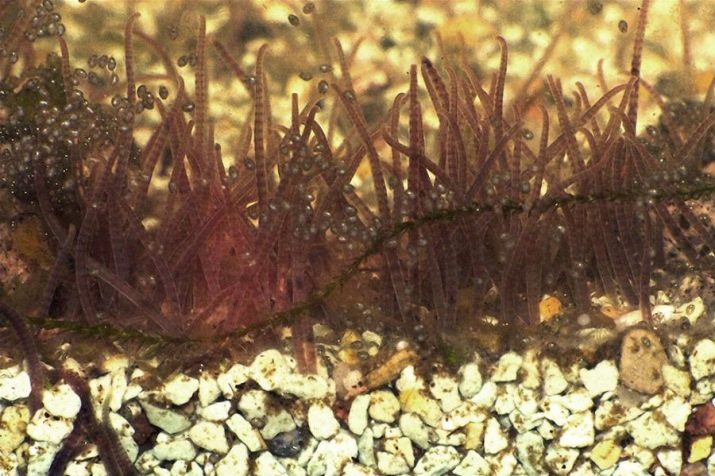
Breeding
Breeding acanthophthalmus requires an aquarist to have certain experience and special knowledge. Spontaneous spawning also occurs, but in most cases, the eggs remain unfertilized and eventually gobble up.
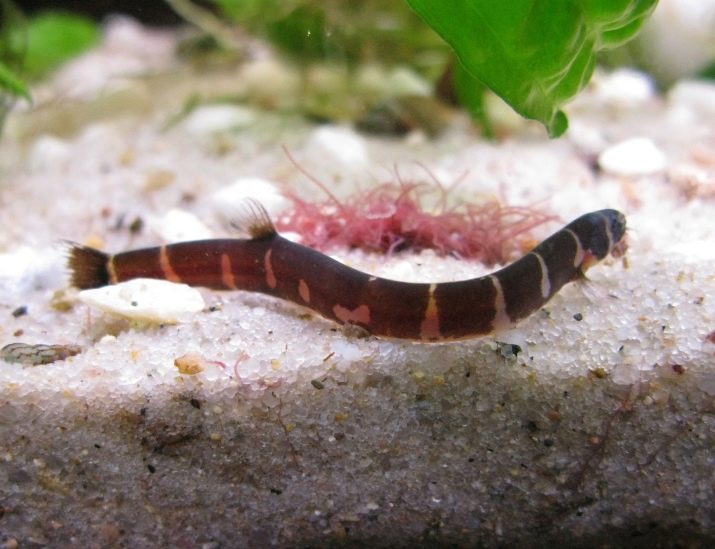
Therefore, for the planned procreation, a number of recommendations should be followed.
- From the general herd, several strong individuals from the age of one year are selected, while the female should have an enlarged abdomen.
- Mildly acidic water is poured into a small aquarium, they cover the bottom with a separate mesh and maintain a temperature of 26-28 degrees.
- Then pour water into a 3-liter jar, 2-3 drops of novocaine are dripped and 5 fish are launched there. After 10 minutes, the fish become numb, they are seized and given them a hormonal injection. To do this, use chorionic gonadotropin at the rate of 60-150 units. for every fish.
- Then individuals are planted in a prepared tank and wait for the start of the rut. 8 hours after the injection, the males begin to hunt for the female: they lean their head against her head and hug the lady with pectoral fins. Soon the steam rises to the surface and the female “shoots” with a portion of small greenish caviar. The eggs sink to the bottom and, thanks to the net, become inaccessible to gluttonous parents.
- After a short time, the "issue" of caviar occurs again and again. As a result, for one spawning, it is possible to collect up to 800 eggs.
- And after a day, the eggs acquire tails, and after 4 days the formation of larvae occurs. As food for them, live dust and grindal are used, and already in a month fry grow up to 2 cm and begin to eat larger live food.
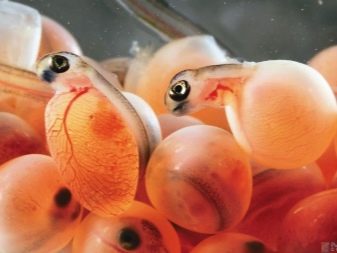

About the content of acantophthalmus see below.
